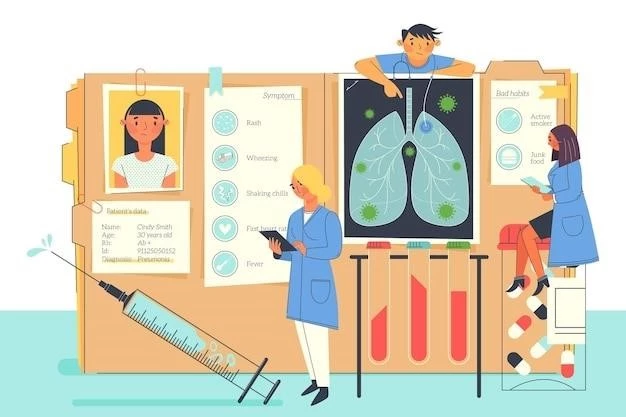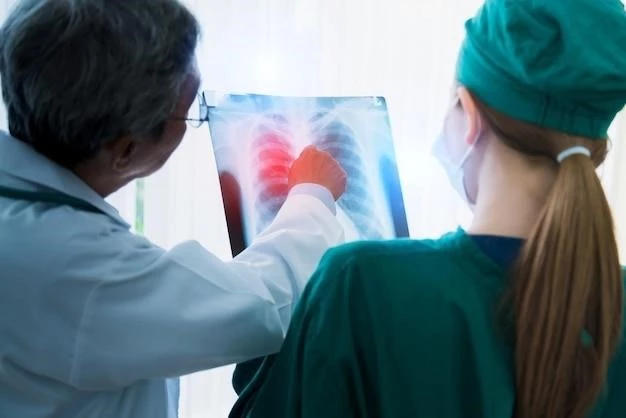Disease ⏤ Lymphangiomatosis, Pulmonary
Lymphangiomatosis is a rare benign disease characterized by the proliferation of abnormal lymphatic vessels in various tissues. When this condition affects the lungs, it is referred to as Pulmonary Lymphangiomatosis. This leads to the formation of cysts filled with fluid in the respiratory system.
I. Overview of Lymphangiomatosis
Lymphangiomatosis is a rare benign disorder characterized by the abnormal proliferation of lymphatic vessels in the body’s tissues. These vessels, part of the lymphatic system, are responsible for fluid balance, immune cell transportation, and fat absorption. In lymphangiomatosis, there is an excessive growth of these vessels, leading to various complications depending on the organs involved.
While lymphangiomatosis can potentially affect any part of the body, pulmonary lymphangiomatosis specifically affects the lungs; The abnormal growth of lymphatic vessels in the lungs can result in the formation of cysts filled with fluid. These cysts can vary in size and number, impacting the respiratory function of the individual.
Due to the rarity of the condition and its diverse manifestations, lymphangiomatosis can present diagnostic and treatment challenges. The understanding of this disease and its effects on the lymphatic system is crucial for better management and outcomes for affected individuals.
II. Understanding the Lymphatic System
The lymphatic system is a vital part of the body’s immune system and plays a crucial role in maintaining fluid balance. It consists of a network of lymphatic vessels, lymph nodes, tonsils, spleen, and thymus. Lymphatic vessels carry a clear fluid called lymph, which contains white blood cells and proteins, throughout the body.
One of the primary functions of the lymphatic system is to help rid the body of toxins, waste, and other unwanted materials. Lymph nodes act as filters along the lymphatic vessels, trapping bacteria, viruses, and cancer cells. The lymphatic system also aids in the absorption of fats from the digestive system and plays a key role in the body’s immune response.
When the lymphatic system is affected by conditions like lymphangiomatosis, the normal functions of the vessels are disrupted. In lymphangiomatosis, there is an abnormal proliferation of lymphatic vessels, leading to the formation of cystic spaces or masses in the affected tissues. This can impair the normal flow of lymph and result in complications specific to the organs involved.
Understanding the intricate workings of the lymphatic system is essential in comprehending the mechanisms underlying diseases like lymphangiomatosis. Proper functioning of the lymphatic system is crucial for overall health and wellbeing, highlighting the significance of diagnosing and managing conditions that impact this vital network.
III. Pulmonary Involvement in Lymphangiomatosis
When lymphangiomatosis affects the lungs, it is known as Pulmonary Lymphangiomatosis. This rare condition involves the abnormal proliferation of lymphatic vessels specifically within the lung tissue. The presence of cysts filled with fluid in the lungs can disrupt normal respiratory function and lead to a range of symptoms.
Pulmonary lymphangiomatosis can impact both children and adults, although it is more commonly diagnosed in pediatric cases. The abnormal growth of lymphatic vessels in the lungs can cause varying degrees of respiratory distress, depending on the extent of cyst formation and their location within the pulmonary tissue.
Due to the intricate structure and function of the lungs, the presence of cystic spaces filled with fluid can hinder the exchange of oxygen and carbon dioxide, leading to symptoms like shortness of breath, coughing, chest pain, and fatigue. The involvement of the lymphatic system in the pulmonary tissue can also increase the risk of infections and inflammation in the lungs.
Understanding the pulmonary manifestations of lymphangiomatosis is crucial for accurate diagnosis and appropriate management of the condition. Healthcare providers need to be aware of the impact of Pulmonary Lymphangiomatosis on respiratory health to provide timely interventions and improve the quality of life for individuals affected by this rare disease.
IV. Symptoms of Pulmonary Lymphangiomatosis
Individuals with Pulmonary Lymphangiomatosis may experience a range of respiratory symptoms due to the presence of cysts in the lung tissue. These symptoms can vary in severity and may include⁚
- Shortness of breath, especially during physical activity
- Persistent coughing
- Chest pain or discomfort
- Fatigue or weakness
- Recurrent lung infections
In some cases, individuals may also exhibit symptoms such as hemoptysis (coughing up blood-stained sputum), wheezing, or cyanosis (bluish discoloration of the skin or lips due to lack of oxygen). The presentation of symptoms can depend on the extent of cystic proliferation within the lungs and the impact on respiratory function.
It is essential for healthcare providers to recognize these symptoms and consider Pulmonary Lymphangiomatosis as a potential differential diagnosis in individuals presenting with persistent respiratory issues. Early identification of symptoms and proper diagnostic evaluation are critical for initiating appropriate treatment strategies and improving outcomes for affected individuals.
V. Diagnosis of Pulmonary Lymphangiomatosis

Diagnosing Pulmonary Lymphangiomatosis can be challenging due to its rarity and the nonspecific nature of its symptoms. Healthcare providers may use a combination of clinical assessments, imaging studies, and laboratory tests to reach an accurate diagnosis.
Imaging studies such as chest X-rays, CT scans, or MRI scans can help visualize the presence of cystic lesions in the lungs characteristic of Pulmonary Lymphangiomatosis. These imaging techniques can also aid in assessing the extent of cystic proliferation and any associated complications.
In some cases, a biopsy of the affected lung tissue may be necessary to confirm the presence of abnormal lymphatic vessels and rule out other potential lung conditions. Analyzing the tissue sample under a microscope can provide definitive evidence of lymphatic vessel proliferation typical of Pulmonary Lymphangiomatosis.
Laboratory tests may be conducted to evaluate lung function, oxygen levels in the blood, and markers of inflammation or infection. Additionally, genetic testing may be considered in cases where there is a suspected genetic component contributing to the development of Pulmonary Lymphangiomatosis.
Collaboration between pulmonologists, radiologists, pathologists, and other healthcare specialists is crucial in achieving an accurate diagnosis of Pulmonary Lymphangiomatosis. Once diagnosed, healthcare providers can formulate a personalized treatment plan based on the individual’s specific condition and symptoms.
VI. Treatment Options for Pulmonary Lymphangiomatosis
The management of Pulmonary Lymphangiomatosis aims to alleviate symptoms, improve respiratory function, and prevent complications associated with the condition. Treatment approaches may vary based on the individual’s age, overall health status, the extent of lung involvement, and the severity of symptoms.
**Observation⁚** In cases where Pulmonary Lymphangiomatosis is asymptomatic or causes mild symptoms, regular monitoring may be recommended to track the progression of the disease and manage symptoms conservatively.
**Medical Management⁚** Symptomatic relief can be achieved through the use of medications such as bronchodilators to help open up the airways, corticosteroids to reduce inflammation, and antibiotics to treat respiratory infections that may occur as a result of compromised lung function.
**Pleural Effusion Management⁚** If pleural effusion (fluid accumulation around the lungs) occurs, drainage procedures such as thoracentesis or pleurodesis may be performed to relieve breathing difficulties and prevent recurrence.
**Sclerotherapy⁚** In some cases, sclerotherapy may be considered to help shrink the cysts within the lungs. This procedure involves injecting a sclerosing agent into the cystic spaces to promote their collapse and reduce fluid accumulation.
**Surgery⁚** Surgical intervention may be necessary in severe cases of Pulmonary Lymphangiomatosis where cysts are significantly impacting lung function. Surgery can involve the resection of affected lung tissue or the removal of large cysts to improve respiratory capacity.
**Lung Transplant⁚** In rare instances where Pulmonary Lymphangiomatosis has caused irreversible lung damage and respiratory failure, a lung transplant may be considered as a last resort treatment option.
It is essential for individuals with Pulmonary Lymphangiomatosis to receive comprehensive care from a multidisciplinary team of healthcare professionals, including pulmonologists, thoracic surgeons, and respiratory therapists. The treatment plan should be tailored to address the specific needs and challenges presented by the individual’s condition to optimize outcomes and quality of life.
VII. Prognosis for Individuals with Pulmonary Lymphangiomatosis
The prognosis for individuals with Pulmonary Lymphangiomatosis can vary depending on factors such as the extent of lung involvement, the presence of complications, the effectiveness of treatment, and the individual’s overall health status. Due to the rarity of the condition and its variable presentation, predicting the long-term outlook can be challenging.
Some individuals with Pulmonary Lymphangiomatosis may experience stable disease with mild symptoms that can be managed effectively with conservative measures and medical interventions. Regular follow-up appointments with healthcare providers are essential to monitor the progression of the disease and adjust treatment as needed.
In cases where Pulmonary Lymphangiomatosis is more severe and leads to significant respiratory impairment, the prognosis may be less favorable. Complications such as recurrent lung infections, pleural effusion, or respiratory failure can impact the individual’s quality of life and overall health outcomes.
Advanced treatment options such as surgery or lung transplantation may be considered in severe cases to improve lung function and quality of life. However, these interventions carry their own risks and considerations, and the decision to pursue them should be made carefully in consultation with a specialized healthcare team.
Overall, the prognosis for individuals with Pulmonary Lymphangiomatosis requires a personalized approach that takes into account the specific characteristics of the disease in each individual case. Continued research and advancements in treatment modalities may offer hope for improved outcomes and quality of life for those affected by this rare pulmonary condition.
VIII. Conclusion
In conclusion, Pulmonary Lymphangiomatosis, a rare condition characterized by the abnormal proliferation of lymphatic vessels in the lungs, poses challenges in diagnosis and treatment due to its rarity and diverse clinical presentations. Understanding the impact of this disease on the respiratory system is essential for timely intervention and improved outcomes.
Individuals with Pulmonary Lymphangiomatosis may experience a range of symptoms affecting their respiratory function, quality of life, and overall well-being. Early recognition of symptoms, accurate diagnosis, and multidisciplinary management are key to addressing the complexities of this condition.
Treatment options for Pulmonary Lymphangiomatosis include conservative measures, medical interventions, surgical procedures, and, in severe cases, lung transplantation. Each treatment approach is tailored to the individual’s specific condition, with a focus on alleviating symptoms, improving lung function, and preventing complications.
The prognosis for individuals with Pulmonary Lymphangiomatosis can vary, with factors such as disease severity, treatment response, and the presence of comorbidities influencing long-term outcomes. Continued research and collaborative efforts in the medical community are crucial in advancing our understanding and management of this rare pulmonary disease.
By raising awareness, promoting early detection, and providing comprehensive care, healthcare providers can make a meaningful difference in the lives of individuals affected by Pulmonary Lymphangiomatosis. Empowering patients with knowledge and support can help navigate the challenges posed by this complex condition and improve their overall prognosis and quality of life.
